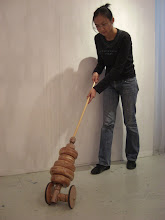-The Greeks or Hellenes (as they called themselves) never formed a single nation, but independent city-states
-they also borrowed ideas, motifs, conventions… from older civilization, like Egypt
_________________________________________
Geometric krater from the Dipylon cemetery 740BCE. 3’4.5” high
Abstract angular motifs
(most early Greek painters decorated vases this way)
-the mourning for a man laid out
-figures: 2 dimensional, triangular frontal torsos
-bottom: the horses have the correct number of heads and legs, but share a common body-> there is no sense of overlapping or depth
Abstract angular motifs
(most early Greek painters decorated vases this way)
-the mourning for a man laid out
-figures: 2 dimensional, triangular frontal torsos
-bottom: the horses have the correct number of heads and legs, but share a common body-> there is no sense of overlapping or depth
Mantiklos Apollo, statuette of a youth
dedicated by Mantiklos to Apollo,
ca.700-680BCE. Bronze 8” high
Orientalizing Art
-long hair, unnaturally elongated neck
Muscles, triangular torso and face..
-motifs borrowed from or inspired by eastern artworks from Egypt, Iraq etc.
-long hair, unnaturally elongated neck
Muscles, triangular torso and face..
-motifs borrowed from or inspired by eastern artworks from Egypt, Iraq etc.
__________________________
The start off of the Archaic Period
 -Lady of Auxerre 650-625BCE 2’1.5”
-Lady of Auxerre 650-625BCE 2’1.5”-Daedalic style (Daedalus used to work in Egypt and learnt a lot form Egyptian Art)
-impact of Egyptian Art
-triangular face, hair
-geometric fondness for abstract pattern
_________________________________
Statuary from the the Archaic Period
Above: Kouros, ca.600BCE. Marble, 6' 1/2" high.
Bottom: Kroisos, from Anavysos, Greece, ca. 530BCE. Marble 6'4"high
-In both Egypt and Greece, the figure is rigidly frontal
-with left foot advanced slightly
-the arms are held beside the body, with the thumbs positioned forward.
Kourous on the left:
-triangular shpae of head and hair
-flatness of the face
-slim waist
-V-shaped ridge of the hips suggest the muscle of the body (though doesn't reproduce very well)
Kroiso on the right:
-Archaic smile
-a more naturalistic manner
-head is not too large/ face is more rounded, with swelling cheeks
-rounder hip instead of the V-shaped ridges
__________________________________________
Temple of Hera I, Paestum, Italy ca 550BCE
- early Doric Temple with heavy, closely spaced, columns
____________________________________
Both are from the Temple of Aphaia, but the one at the top was installed earlier.
Top: Dying warrior, from the west pediment of the Temple of Aphaia, Aegina, Greece. ca 490 BCE. Marble 5'1/2"long
Bottom: Dying warrior from the east pediment of the Temple of Ahpaia, Aegina, Greece. ca 480BCE. Marlbe 6'1"long.
The west pediment's warrior (above) is still in the Archaic mode:
-His torso is rigidly frontal
-he looks out directly at the viewers
-with the Archaic smile, even though he has got an arrow in his chest.
The east pediment's warrior is very different
-more natural and more complex
-his torso placed at an angle to the viewer
-he reacts to this wound more naturally
-he is not looking at the viewers, but is concerned with his own pain
**** This statue belongs to the Classical world, where statues move as humans move and has the self-consciousness of real men and women. *****
訂閱:
張貼留言 (Atom)











沒有留言:
張貼留言